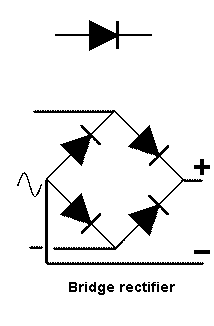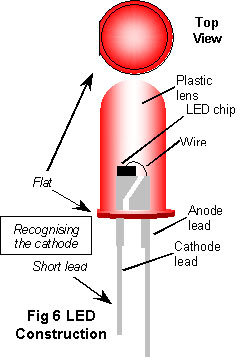More Diodes
More Diodes
Diodes come in a vast variety of types for many special purposes. This page introduces some of the more common types:
Silicon rectifiers

Have large junction areas so that they are able to pass large forward currents (some types can pass tens of Amperes). An important parameter of these diodes is there ability to withstand large reverse voltages. For example a typical mains rectifier must be able to withstand reverse voltages of at least 1000v (allowing a margin for safety) as the peak to peak voltage of the 240v mains is nearly 700v. They are available either packaged as single diodes or in a "bridge" arrangement with four diodes ready wired to act as an efficient "full wave" rectifier. (The action of full wave rectifiers will be explained later in the description of power supplies).
Silicon Signal Diodes

Silicon diodes with a small junction area are used for demodulation except at VHF and above where the capacitance of the junction becomes too big. They are more reliable than point contact types, have less leakage current ( <10nA ), have a greater useful temperature range and can withstand higher reverse voltages.
Germanium Point Contact Diodes

An early type of diode based on the "cats whisker" principle, still used for demodulation of radio signals. It has the advantage for this purpose of only requiring an anode potential only very slightly more positive than that on its cathode, and so will operate with peak-to-peak signal voltages of only a few milli-volts. It will also work at very high frequencies. It is however quite fragile and has a relatively large ( >10ľA ) leakage current. Silicon junction types have largely replaced it at lower radio frequencies.
Zener Diodes

These diodes are heavily doped to give them a very thin depletion layer. In use they are reverse biased. No current will flow (apart from a very small leakage current) until the "breakdown voltage" is reached. In any diode, there comes a point where, if sufficient reverse voltage is applied, "reverse current" will flow from cathode to anode. The tightly bound valence electrons in the depletion region are torn away from their atoms and there is a sudden large increase in current. If this current is allowed to build up to too high a value permanent damage will result. However, provided the reverse current is limited to a safe value, the diode will not be damaged and once the reverse voltage is reduced the diode stops conducting once more.
It is this sudden increase in reverse current, happening at a precise voltage (controlled by the amount of doping), which gives the Zener diode its ability to act as a voltage stabiliser and voltage reference source. It creates a large and sudden increase in current at a precise applied voltage.
Light Emitting Diodes (LEDs)


These diodes are made from a range of semiconductor materials, depending on the colour of light required.
Gallium Arsenide Phosphide (GaAsP) = Red
Gallium Phosphide (GaP) = Green
Gallium Indium Phosphide (GaInP) = Yellow
In any semiconductor material, energy is released whenever an electron recombines with a hole. In silicon this energy is released in the form of heat, but in other materials, particularly Gallium Arsenide, this energy is released in the form of Infra Red radiation. By adding other materials to the semiconductor the wavelength of the energy given of can be altered and thus LEDs can be made to radiate their energy at particular frequencies within the visible spectrum.